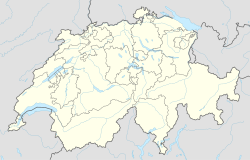Stadel bei Niederglatt
| Stadel bei Niederglatt | ||
|---|---|---|
 |
||
|
||
| Coordinates: 47°32′N 8°28′E / 47.533°N 8.467°ECoordinates: 47°32′N 8°28′E / 47.533°N 8.467°E | ||
| Country | Switzerland | |
| Canton | Zurich | |
| District | Dielsdorf | |
| Government | ||
| • Mayor | Peter Bernhard | |
| Area | ||
| • Total | 12.9 km2 (5.0 sq mi) | |
| Elevation | 436 m (1,430 ft) | |
| Population (Dec 2015) | ||
| • Total | 2,210 | |
| • Density | 170/km2 (440/sq mi) | |
| Postal code | 8174 | |
| SFOS number | 0100 | |
| Localities | Stadel, Windlach, Raat, Schüpfheim | |
| Surrounded by | Glattfelden, Hochfelden, Neerach, Bachs, Weiach | |
| Website |
www SFSO statistics |
|
Stadel is a municipality in the district of Dielsdorf in the canton of Zürich in Switzerland.
Stadel has an area of 12.9 km2 (5.0 sq mi). Of this area, 58.8% is used for agricultural purposes, while 30.4% is forested. Of the rest of the land, 10.2% is settled (buildings or roads) and the remainder (0.5%) is non-productive (rivers, glaciers or mountains).
To distinguish between several places having the same name, this one is suffixed by the addition of bei Niederglatt (German: near Niederglatt). Besides the village of Stadel the municipality comprises the three hamlets Windlach, Raat, and Schüpfheim.
Stadel has a population (as of 31 December 2015) of 2,210. As of 2007[update], 10.5% of the population was made up of foreign nationals. Over the last 10 years the population has grown at a rate of 21.8%. Most of the population (as of 2000[update]) speaks German (93.7%), with English being second most common ( 1.2%) and French being third ( 0.6%).
In the 2007 election the most popular party was the SVP which received 54.2% of the vote. The next three most popular parties were the CSP (9.2%), the SPS (8.6%) and the FDP (8.4%).
The age distribution of the population (as of 2000[update]) is children and teenagers (0–19 years old) make up 23.1% of the population, while adults (20–64 years old) make up 63% and seniors (over 64 years old) make up 14%. In Stadel about 80.3% of the population (between age 25-64) have completed either non-mandatory upper secondary education or additional higher education (either university or a Fachhochschule).
...
Wikipedia



